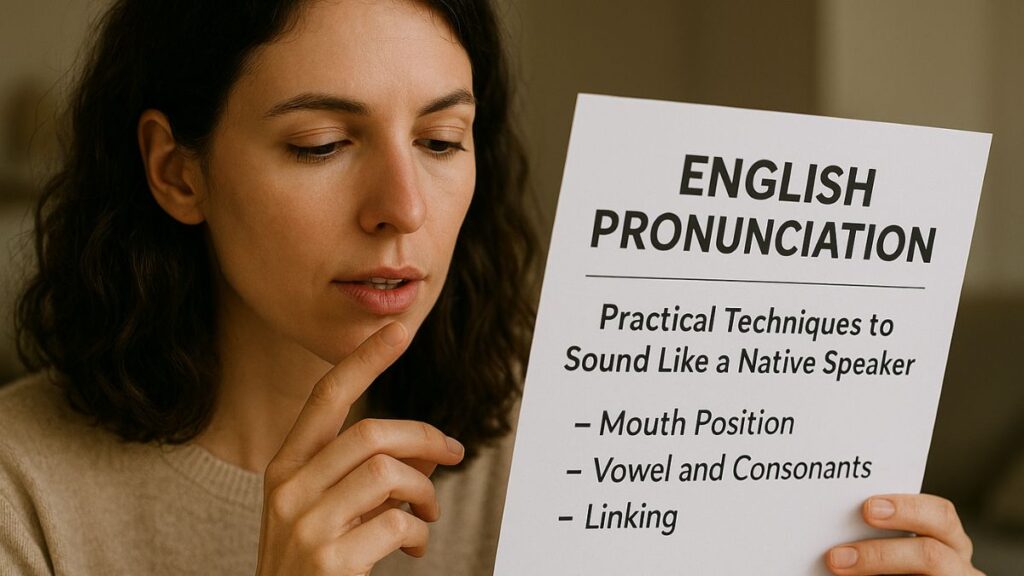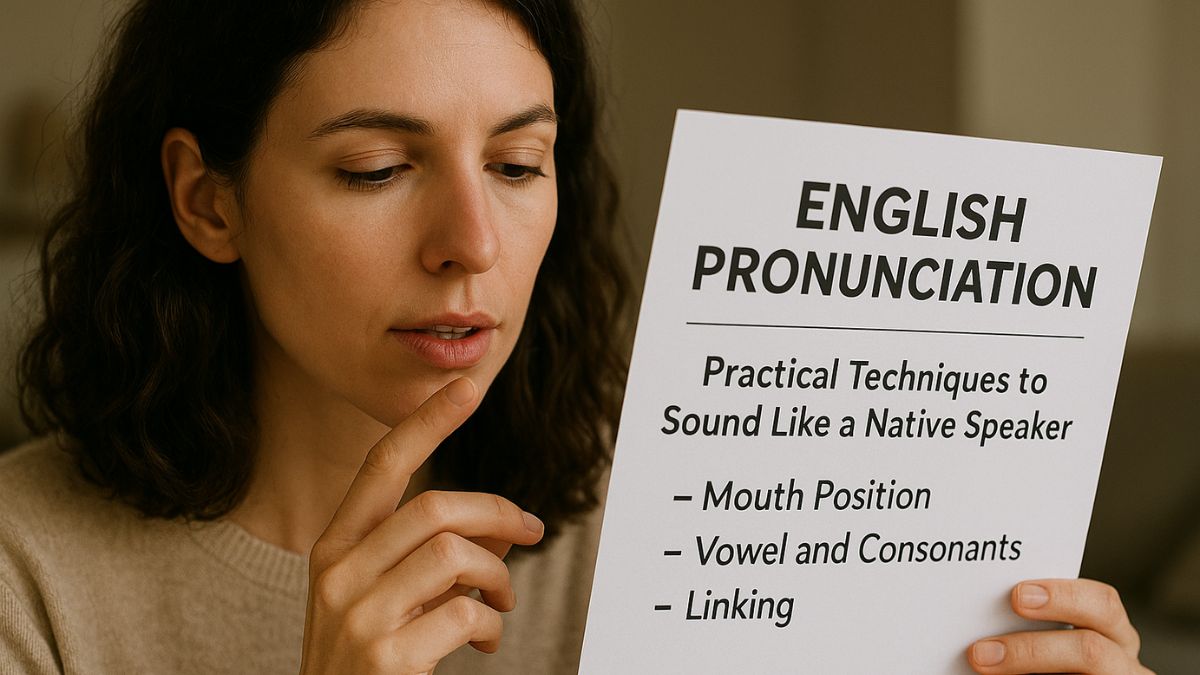Introduction
Pronunciation is a key part of learning English. Whether you’re a beginner or an advanced speaker, improving your speech can help you communicate more clearly and feel more confident.
In this article, you’ll explore:
- The basics of English pronunciation (A1–A2)
- Key pronunciation mistakes and how to fix them
- Native-sounding techniques (B1–B2)
- Practical tools and classroom ideas for learners and teachers
- And a complete FAQ to guide your practice
Speaking clearly is essential for effective conversations, whether you’re learning a new language or refining your skills. The way words sound can vary widely between accents, like British and American styles. This guide helps you understand these differences and improve your speech.

According to the Cambridge Dictionary, pronunciation refers to how a word or letter is spoken. Recognizing accents and mastering sounds like those in Received Pronunciation (RP) or General American can boost your confidence. This guide includes interactive audio clips and practical tips to make learning engaging.
We’ll break down key techniques, provide a downloadable IPA chart, and link to targeted lessons. Whether you’re a beginner or intermediate learner, this resource helps you speak with clarity.
Key Takeaways
- Pronunciation shapes how others understand your words.
- British and American accents have distinct sounds.
- Interactive audio clips make learning engaging.
- An IPA chart helps decode tricky sounds.
- Clear speech builds confidence in conversations.
English Pronunciation Basics for Beginners
Getting started with speech can feel overwhelming, but breaking it down makes it manageable. The way we form sounds impacts how others understand us. This section covers core concepts to build a strong foundation.
Learn the foundation: sounds, syllables, and stress
Understanding the basic components of speech is crucial for any language learner. Sounds are the building blocks of speech, and recognizing the different phonemes in English can greatly enhance your ability to communicate. Syllables help to structure words, making them easier to articulate and comprehend.
On the other hand, stress plays a vital role in conveying meaning; emphasizing the correct syllable can change the definition of a word entirely. For instance, the word ‘record’ can be a noun or a verb depending on which syllable is stressed. Mastering these elements not only aids in clarity but also boosts confidence when speaking with others.
Best for A1–A2 students
This level is crucial for beginners in language learning, as it lays the foundation for future communication skills. At the A1–A2 levels, students are often grappling with basic vocabulary and simple sentence structures. They are beginning to develop their understanding of pronunciation, which is essential for clear communication.
-------- Continua após a publicidade --------
By focusing on pronunciation, these learners can improve their ability to be understood and to understand others. Mastering the sounds of English at this stage not only aids in their immediate learning but also builds a strong base for more advanced language skills in the future.
The Importance of Accurate Sound Production
Articulation isn’t just about saying words correctly—it’s about being understood. Clear speech helps in everyday conversations, professional settings, and learning new languages. The Oxford Advanced Learner’s Dictionary highlights how small sound changes alter meanings.
For example, /θ/ in “thin” and /ð/ in “this” may look similar but sound different. Mastering these distinctions prevents confusion. Proper tongue placement and airflow create precise sounds.
Essential American English Sounds
American speech has distinct characteristics. The /r/ sound appears in all positions, unlike some other accents. Key vowel differences include:
| Sound | Example Word | IPA Symbol |
|---|---|---|
| /æ/ | cat | [kæt] |
| /ɑː/ | father | [ˈfɑːðər] |
| /iː/ | sheep | [ʃiːp] |
| /ɪ/ | ship | [ʃɪp] |
Minimal pairs like “bad” (/bæd/) and “bed” (/bɛd/) show how tiny sound shifts change meanings. Audio examples help train your ear to catch these differences.
Decoding Words with IPA Symbols
The International Phonetic Alphabet (IPA) provides a universal way to represent sounds. It’s especially helpful for words where spelling doesn’t match pronunciation.
- enough = /ɪˈnʌf/
- through = /θruː/
- colonel = /ˈkɜːrnəl/
Interactive exercises from learner dictionaries make practicing IPA symbols engaging. Start with common words and gradually tackle more complex ones.
Common Pronunciation Mistakes (and How to Fix Them)
Spelling and articulation often don’t match, creating common errors. These mistakes can make speech harder to understand. Focusing on silent letters, sound pairs, and spelling quirks helps clear confusion.
Silent Letters and Misplaced Stress
Many words contain letters you don’t pronounce. For example, the “k” in “knight” or the “p” in “psychology” stay silent. Misplaced stress also changes meanings, like “RE-cord” (noun) vs. “re-CORD” (verb).

- Wednesday: Pronounced “WENZ-day” (silent “d”).
- Debt: Sounds like “det” (silent “b”).
Specific errors common among Portuguese speakers
One of the primary challenges for Portuguese speakers learning English is the difficulty in distinguishing between certain sounds that do not exist in their native language. For instance, the /ʃ/ sound, as in “ship,” can often be confused with the /s/ sound, leading to mispronunciations. Additionally, the /v/ and /b/ sounds may be interchanged, resulting in words like “very” being pronounced as “berry.”
Another common issue is the use of vowel sounds; Portuguese speakers might struggle with the English short and long vowel distinctions, such as the difference between “ship” and “sheep.” This can lead to misunderstandings in communication. To help overcome these challenges, focused listening exercises and speech practice can be incredibly beneficial. Utilizing resources that emphasize these sound distinctions will greatly assist learners in achieving clearer pronunciation.
Practice drills included various techniques designed to improve speech and reinforce the understanding of similar sounds. These drills can involve repetition of specific words and phrases that challenge learners, focusing on the subtle differences that may exist between similar sounds.
For example, learners can practice pairs of words like “bat” and “pat” to distinguish between the /b/ and /p/ sounds. Additionally, incorporating tongue twisters can be an effective way to enhance fluency and confidence in speaking.
By regularly engaging in these exercises, learners not only build muscle memory but also develop a better ear for the nuances of English pronunciation. This consistent practice is essential for overcoming the challenges posed by sounds that do not exist in their native language, ultimately leading to clearer and more effective communication.
For additional tips and practical video examples, check out this detailed guide by the BBC Learning English: BBC Learning English – The Sounds of English
This resource offers high-quality pronunciation lessons focusing on individual sounds, word stress, and connected speech. It’s an excellent complement for learners who want to practice listening and mimic native pronunciation effectively.
Confusing Similar Sounds (e.g., /θ/ vs. /ð/)
The /θ/ sound (as in “think”) and /ð/ (as in “this”) often trip learners up. Both use the tongue between teeth, but /ð/ adds vocal cord vibration. Try these pairs:
“Thin” (/θɪn/) vs. “then” (/ðɛn/).
Mouth diagrams and slow repetition build muscle memory. Over time, these features become natural.
Why “Spelling Doesn’t Equal Pronunciation”
This question often puzzles learners of English, as the language is filled with exceptions and irregularities. English spelling has been influenced by various languages over centuries, including Latin, French, and Germanic languages, leading to a complex relationship between how words are spelled and how they sound. For instance, the word “though” is pronounced quite differently from how it is spelled, showcasing the unpredictable nature of English phonetics.
Additionally, many words are borrowed from other languages, which can further complicate speech rules. The presence of silent letters, such as in “knight” or “island,” adds another layer of confusion. Understanding these nuances is essential for mastering English pronunciation and can significantly enhance your speaking skills.
Historical accents and borrowed words caused irregularities. For instance, “colonel” sounds like “kernel” due to French influence. Even “pronunciation” is often mispronounced as “pro-noun-ciation.”
Tips to navigate mismatches:
- Use IPA symbols (e.g., /ˈkɜːrnəl/ for “colonel”).
- Listen to native speakers via audio clips.
- Practice stress patterns in multisyllabic words.
10 Practical Techniques to Sound Like a Native Speaker
Want to sound like a native? These actionable strategies bridge the gap between learning and fluency. Whether you’re practicing alone or with resources, consistency is key. Below are how to improve speech methods backed by linguists and educators.

Shadowing: Mimic Native Speakers with Audio
Shadowing builds muscle memory by repeating speech in real time. Use TED Talks or podcasts with transcripts:
- Listen to a short clip (10–20 seconds).
- Pause and repeat, matching tone and pace.
- Record yourself and compare.
Focus on stress patterns and linking words (e.g., “wanna” for “want to”).
Tongue and Mouth Positioning for Tricky Sounds
Precise articulation makes sounds like /l/ (light vs. dark L) clearer. For the dark L in “ball,” the tongue curls back slightly. MRI studies show native speakers’ tongue placement differs for similar sounds.
“Glottal stops [ʔ] replace /t/ in casual speech—e.g., ‘mountain’ (/ˈmaʊnʔən/).”
Using Songs to Master Rhythm and Intonation
Music trains your ear for natural phrasing, allowing you to internalize the rhythm and intonation patterns of a language. Engaging with songs can significantly enhance your listening skills and help you develop a more authentic accent. Try these pronunciation activities with clear-enunciation artists who excel in conveying emotion and clarity:
- Adele: Emphasizes vowel elongation, which can help learners recognize and produce long vowel sounds more accurately.
- Ed Sheeran: Uses conversational rhythm, making his songs a great resource for understanding everyday speech patterns and informal expressions.
Sing along, focusing on stressed syllables and pauses to enhance your fluency and expressiveness. Pay attention to how these artists use dynamics and pitch variations to convey meaning.
For daily practice, download a glottal stop-focused tongue-twister PDF. Phrases like “button bottle” sharpen quick sound transitions and help you master tricky consonant clusters, improving your overall speech skills.
A sound table with examples:
| Artist | Sound Pattern | Example Phrase |
|---|---|---|
| Adele | Vowel Elongation | “Hello from the other side” |
| Ed Sheeran | Conversational Rhythm | “Shape of You” |
Understanding the Rules Behind Pronunciation
Mastering pronunciation involves understanding the hidden rules that shape spoken language. Stress patterns, accents, and advanced features like glottal stops all play a role. This section breaks down these elements for advanced learners.
Stress Patterns in Words and Sentences
Word stress changes meaning significantly in spoken language. For example, “CON-tent” (noun) refers to the material contained within something, while “con-TENT” (adjective) describes a state of satisfaction or happiness. Understanding this distinction is crucial for effective communication. Sentences also follow stress rules that dictate which words to emphasize for clarity and meaning:
- Content words (nouns, verbs) are stressed to convey the main ideas of a sentence.
- Function words (prepositions, articles) are softer and serve to connect the content words, providing grammatical structure.
News anchors emphasize stress clearly, using it to highlight important information and maintain audience engagement. Try mimicking their delivery for practice, paying attention to how they stress certain words to enhance the message they convey.
How Accents Affect Pronunciation
British and American accents differ in vowel sounds and rhythm. Compare:
| Sound | British Example | American Example |
|---|---|---|
| /ɒ/ vs. /ɑː/ | lot (/lɒt/) | father (/ˈfɑːðər/) |
| /r/ pronunciation | Silent in “car” (/kɑː/) | Pronounced (/kɑːr/) |
Regional accents, like Scottish /x/ in “loch,” add further variety.
Glottal Stops and Other Advanced Features
A glottal stop (IPA: [ʔ]) replaces /t/ in casual speech. For example:
“Button” becomes /ˈbʌʔən/.
Syllabic consonants, like the /l/ in “finally” (/ˈfaɪnəli/), are another feature. Practice with these transcriptions:
- “Bottle” = /ˈbɒʔl̩/ (British) or /ˈbɑːʔl̩/ (American).
- “Urban” = /ˈɜːbən/ (syllabic /n/).
speech for Real-Life Situations
Clear speech opens doors in professional and social settings. Whether you’re prepping for a job interview or chatting with friends, adapting your tone and clarity matters. This esl pronunciation guide covers strategies for formal and casual scenarios, emphasizing the importance of articulation and the ability to convey your message effectively.
Clear Speech for Job Interviews and Professional Settings
Formal settings demand precise articulation. Avoid reductions like “gonna” and emphasize full words (“going to”) to ensure clarity and professionalism. When you speak clearly, you project confidence and competence, which can significantly impact the impression you make on potential employers. Practice these industry-specific word lists to familiarize yourself with the correct pronunciation:
- Tech: “algorithm” (/ˈælɡəˌrɪðəm/), “debugging” (/diːˈbʌɡɪŋ/), “software” (/ˈsɔːf.tweər/), and “networking” (/ˈnɛt.wɜː.kɪŋ/).
- Medical: “diagnosis” (/ˌdaɪəɡˈnoʊsɪs/), “pharmacy” (/ˈfɑːrməsi/), “treatment” (/ˈtriːt.mənt/), and “prescription” (/prɪˈskrɪp.ʃən/).
Tip: Record answers to common questions (“Tell me about yourself”) and compare them to native samples. This will help you identify areas for improvement and build your confidence in speaking.
Everyday Conversations: Contractions and Reductions
Casual speech thrives on shortcuts. Weak forms like /kən/ (“can”) or /ʃʊdə/ (“should have”) sound natural in everyday conversations, making speech flow more smoothly and helping speakers sound more relaxed and approachable. These reductions are often used in informal settings, allowing for a more conversational tone. Examples:
“I wanna go” (want to), “Lemme see” (let me), “Gimme a break” (give me), and “Shoulda told me” (should have).
Note: Context matters significantly. Use reductions with friends and in informal situations, where a relaxed tone is appropriate, but switch to full forms in presentations or formal discussions to maintain clarity and professionalism. This shift in speech style can impact how your message is received and understood by your audience.
Interactive Practice: Record and Compare Your Speech
How to sound fluent in english? Self-assessment is key. Try this:
- Pick a short audio clip (e.g., a news snippet or a podcast segment that interests you).
- Record yourself repeating it, paying attention to your intonation and pronunciation.
- Compare stress, rhythm, and linking words with the original audio, noting areas where you can improve.
For quick checks, use the dictionaries like Cambridge’s pronunciation tool, which provides audio examples for various words and phrases, helping you to hear the nuances of native speech.
Tips for Teachers
Some classroom strategies and articulation correction techniques that can be highly effective include using visual aids, such as phonetic charts, to help students understand the sounds of English better. Incorporating interactive activities, like role-playing or speech games, can also engage students and make learning more enjoyable. Additionally, providing immediate feedback during speaking exercises is crucial, as it allows learners to adjust their speech in real-time.
Encourage peer feedback as well, fostering a collaborative learning environment where students can support each other in their articulation journeys. Furthermore, utilizing technology, such as language learning apps that focus on pronunciation, can enhance the learning experience by offering personalized practice opportunities.
🎧 Want to dive deeper into how pronunciation varies across regions?
Don’t miss our article on English Accents: Top Features That Distinguish Regional Speech.
It explores the unique characteristics of different English accents and how they influence the way we pronounce words. Understanding these variations can help you improve both your listening skills and pronunciation accuracy!
Conclusion
Achieving clear communication requires dedication, but the appropriate resources can simplify the process. Engaging in shadowing native speakers and interpreting IPA symbols are techniques that enhance confidence. Pay attention to stress patterns and challenging sounds such as glottal stops to achieve natural fluency.
Continue your education with tools like the Cambridge Dictionary or the Oxford Learner’s Dictionary. Their audio samples and word lists improve precision. For practical experience, participate in our monthly challenge, which includes expert feedback.
Ready to start? Download a free IPA chart and 15-minute daily practice schedule. Remember: small, consistent efforts create lasting improvement. Speak clearly, and let your words shine.
FAQ
What is the difference between British and American pronunciation?
Key differences include vowel sounds (e.g., “dance” /æ/ in American vs. /ɑː/ in British) and the use of glottal stops. Stress patterns and intonation also vary.
How can I improve my accent quickly?
Focus on shadowing native speakers, practicing tongue positioning, and using tools like the Cambridge Dictionary for audio examples. Consistent daily drills yield faster results.
Why do silent letters exist in English?
Many silent letters reflect historical spelling conventions. For example, the “k” in “knight” was once pronounced but evolved over time.
What’s the best way to learn IPA symbols?
Start with common symbols (like /θ/ for “think”) using interactive charts. Pair them with audio from learner dictionaries for reinforcement.
How do I master stress patterns in sentences?
Listen to native speakers in real-life contexts (e.g., podcasts). Emphasize content words (nouns, verbs) over function words (prepositions, articles).
Can songs really help with pronunciation?
Yes! Music teaches rhythm, linking sounds, and intonation. Try singing along to tracks with clear lyrics, like those from BBC Learning English playlists.
What tools can I use to check my pronunciation?
Use apps like Elsa Speak or record yourself comparing against native speaker audio in dictionaries like Oxford Advanced Learner’s Dictionary.







